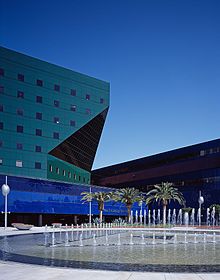|
"Explore Neighborhoods Within Neighborhoods"
| |
|
"Explore Neighborhoods Within Neighborhoods"
| |
West Hollywood PropertiesWest Hollywood is bordered on the north by the Hollywood Hills, just east of Beverly Hills, west of Hollywood and north of the Miracle Mile & Beverly Center neighborhoods. HistoryMost historical writings about West Hollywood began in the late 18th century with European colonization when the Portuguese explorer Juan Cabrillo arrived offshore and claimed the already inhabited region for Spain. Around 5,000 of the indigenous inhabitants from the Tongva Indian tribe canoed out to greet Juan Cabrillo. The Tongva tribe was a nation of hunter-gatherers known for their reverence of dancing and courage. By 1771, these native people had been severely ravaged by diseases brought in by the Europeans from across wide oceans. The Spanish mission system changed the tribal name to "Gabrielinos", in reference to the Mission de San Gabriel. By 1780, what became the "Sunset Strip" was the major connecting road for El Pueblo de Los Angeles, and all ranches westward to the Pacific Ocean. This land passed through the hands of various owners during the next one hundred years, and it was called names such as "La Brea" and "Plummer" that are listed in historical records. Most of this area was part of the Rancho La Brea, and eventually it came to be owned by the Henry Hancock family. During the final decade years of the nineteenth century, the first large land development in what would later become West Hollywood—the town of "Sherman"—was established by Moses Sherman and his partners of the Los Angeles and Pacific Railway, an interurban railroad line which later became part of the Pacific Electric Railway system. Sherman became the location of the railroad's main shops, railroad yards, and "car barns". Many working-class employees of the railroad settled in this town. It was during this time that the city began to earn its reputation as a loosely regulated, liquor-friendly (during Prohibition) place for eccentric people wary of government interference. Despite several annexation attempts, the town elected not to become part of the City of Los Angeles. In a controversial decision, in 1925 Sherman adopted "West Hollywood,"...a moniker pioneered earlier in the decade by the West Hollywood Realty Board" as its informal name. though it remained under the governance of Los Angeles County. For many years, the area that is now the City of West Hollywood was an unincorporated area in the midst of Los Angeles. Because gambling was illegal in the City of Los Angeles, but still legal in Los Angeles County, the 1920s saw the proliferation of many casinos, night clubs, etc., along Sunset Boulevard. These businesses were immune from the sometimes heavy-handed law-enforcement of the L.A. Police Department. Some people connected with movie-making were attracted to this less-restricted area of the County, and a number of architecturally distinctive apartment buildings and apartment hotels were built. In 1984, residents in West Hollywood organized to maintain rent control. When Los Angeles County began planning to discontinue rent controls, West Hollywood was a densely populated area of renters, many of whom would not be able to afford to keep up with the generally rapid raises in rent in the Los Angeles area. A tight coalition of residents swiftly voted to incorporate as the "City of West Hollywood". West Hollywood then immediately adopted one of the strongest rent control laws in the nation. Landmarks and distinctive places
Alta Loma Road is home to the Sunset Marquis Hotel with its famous 45-person Whisky Bar and a recording studio that has been home to many hits. Alta Loma Road was one of the main locations for the film Perfect. The western stretch of Melrose Avenue, between Fairfax Avenue and Doheny Drive, is notable for its trendy clothing boutiques, interior design shops, restaurants and antique stores. The west end of Melrose Avenue, near the Pacific Design Center, is especially known for its exclusive furniture. The area around Fountain Avenue, Harper Avenue and Havenhurst Drive contains a high concentration of landmark 1920s Spanish Revival and Art Deco apartment buildings by such noted architects as Leland Bryant. This historic district has been home to many celebrities and at one time the Sunset Tower at 8358 Sunset Boulevard was home to Frank Sinatra, Errol Flynn, the Gabor sisters, John Wayne and Howard Hughes. Notable business and attractions in West Hollywood include:
Neighborhoods
Preview all properties for sale below: Preview all income properties for sale here: |